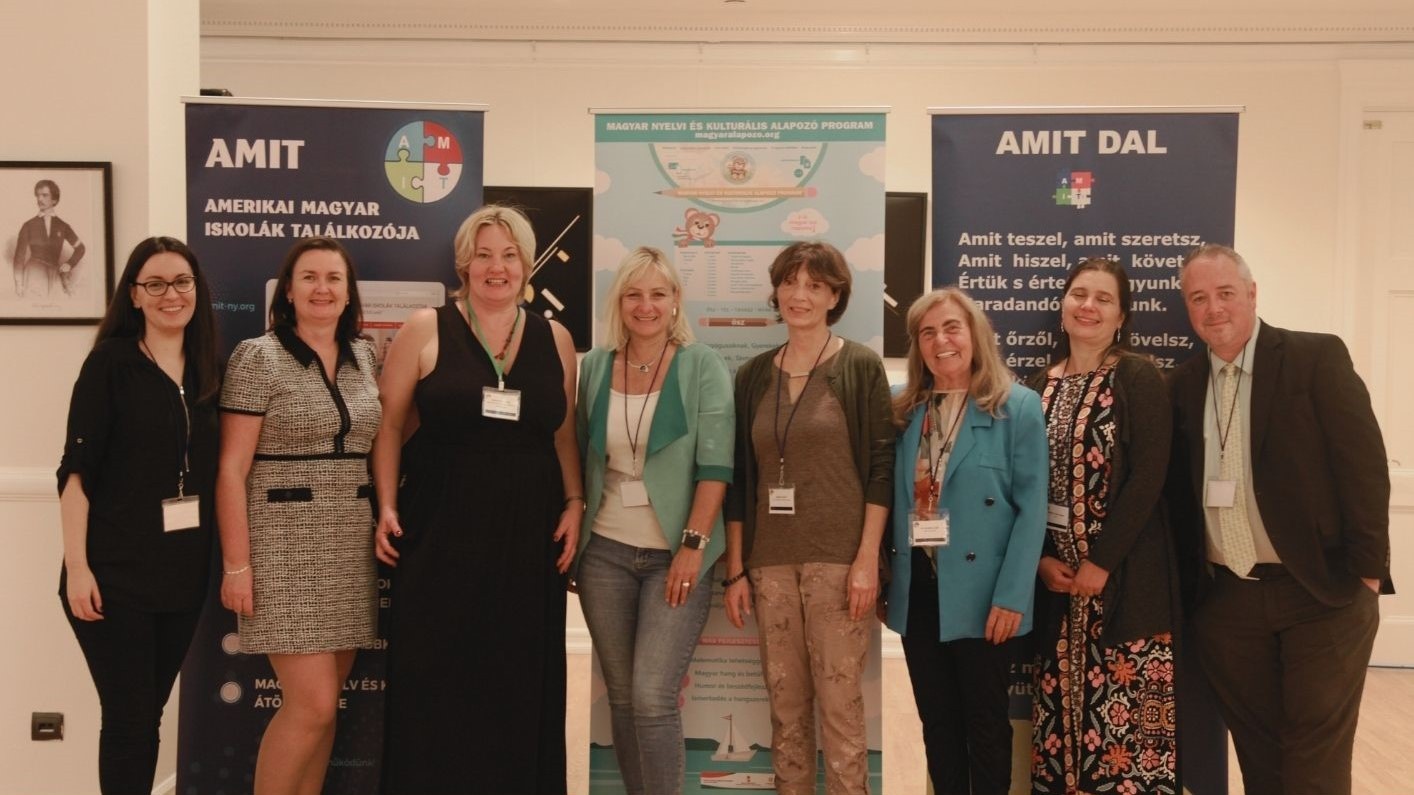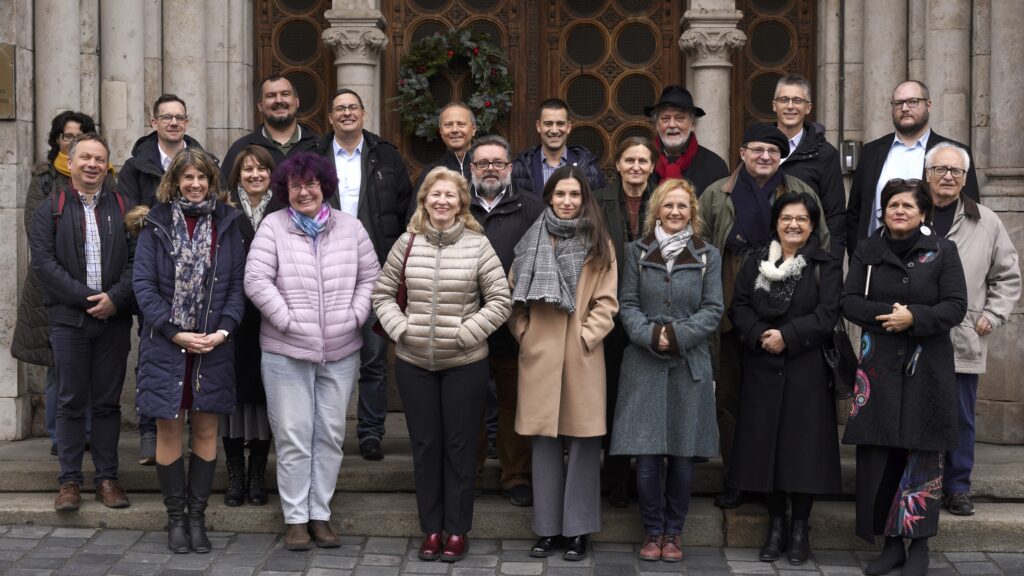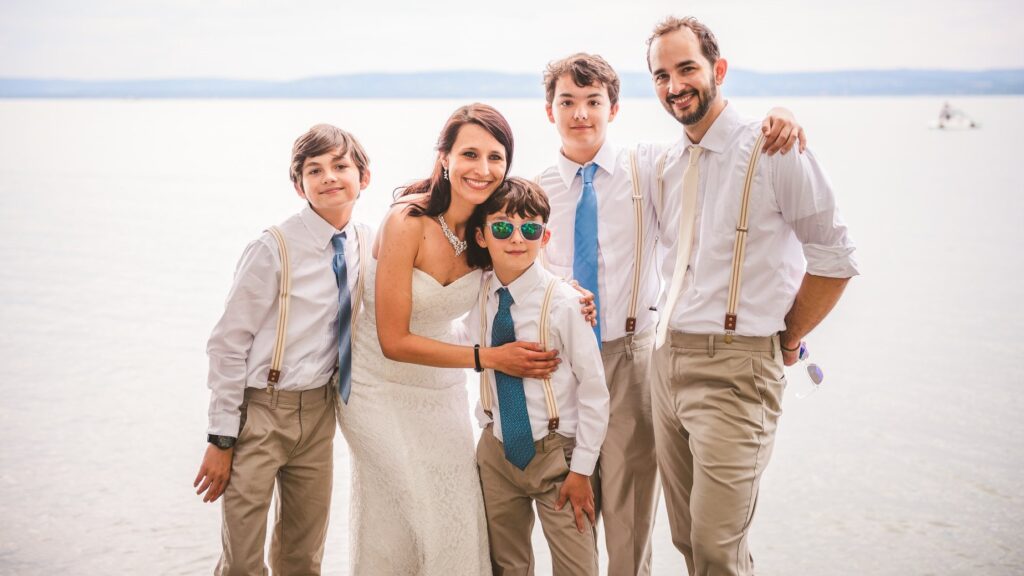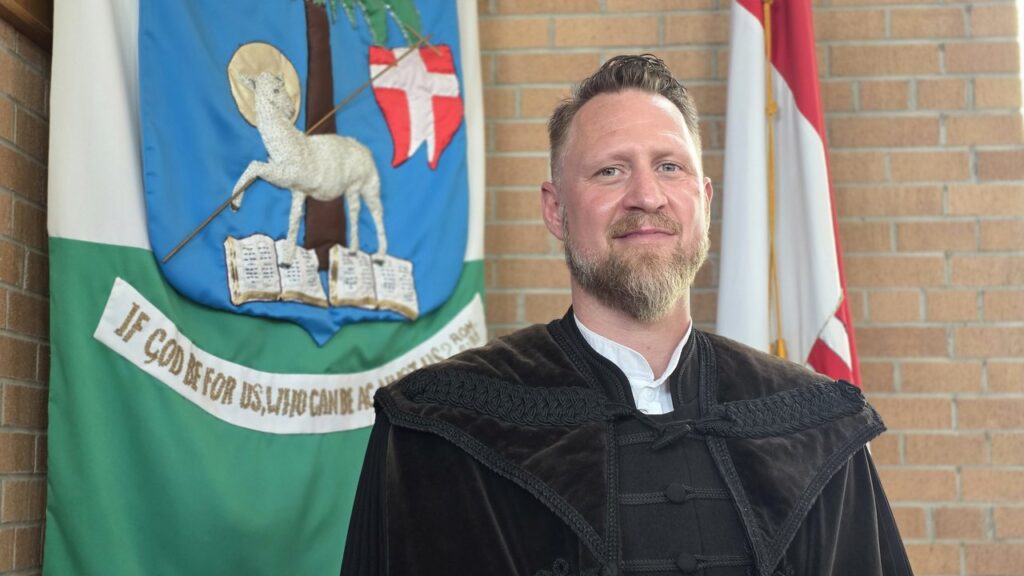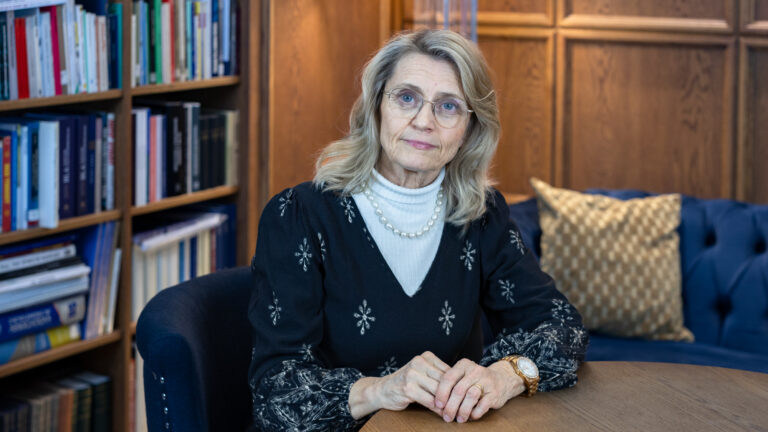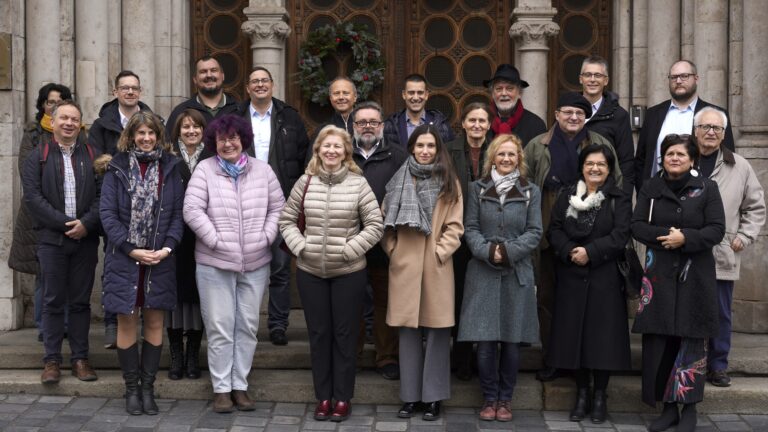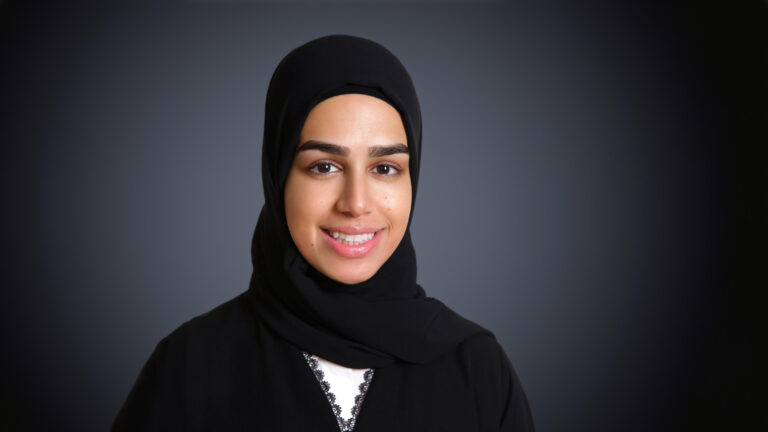Kati first moved from Hungary to Bielefeld, Germany due to her husband’s work, and then 22 years ago to Long Island, New York, where she has sought to put her German language teaching skills to use in multiple ways: first for the families of her husband’s colleagues, by leading an international playgroup and preschool, by teaching in a German language school, and later by being a principal of the Arany János Hungarian School; and finally by co-founding and leading the American Hungarian Schools’ Association (AMIT), which unites nearly 50 Hungarian weekend schools across North America.
***
How did you come to America?
I graduated in Debrecen, Hungary as a German language teacher, where I met my nuclear physicist husband. At the end of the 1990s he got a postdoctoral position in Bielefeld, Germany, where I pursued my studies at the university in pedagogy, German studies, German as a foreign language, and completed my teaching practice. After spending three years there, we moved with our 1,5-year-old daughter to America 22 years ago, as my husband got a job in the Brookhaven National Laboratory (BNL) on Long Island. He is still working there, and I’ve been trying to figure out my role and mission ever since. First I threw myself into the BNL Hospitality Committee, an organization operating for the benefit of the staff’s families. I joined English classes, swimming, music programs and the library offering all kinds of children’s activities. I also completed the Suffolk Literacy tutor training and later became an English tutor at BNL. During this time I met many mothers in similar situations, all of whom had to leave not only their families and friends, but also give up their careers. First we created a playgroup, then a nursery school (Uptown Nursery School) that I presided over. The school had seven children, while he playgroup had 15 to 20 children, sometimes even 30; for example, when we organized Halloween parties or Easter egg hunts.
I assume English was the common language in this international environment.
Yes. As we had scientists from all over the world in the laboratory, the playgroup, the nursery school and our circle of friends were all very international. We helped each other in such a way that over 20 years, strong friendships were forged with these educated, intelligent and worldly-minded people. After a while we left the organized community and carried on with a small, tight-knit group of friends meeting on each Friday at one of our houses. It was a happy period of my life.
My husband is now a group leader; we bought our own house on the beach—we practically live the American dream; however, I sometimes feel stuck career-wise because I volunteer so much that I don’t have time for anything else. America teaches you to give something back to the community. Perhaps this is not so common in Hungary. People often ask: how much money do you get for it, what do you get out of it? My answer is that I meet good and interesting people, my network of contacts grows, which is the biggest asset nowadays—in short: we shouldn’t measure everything in financial terms.
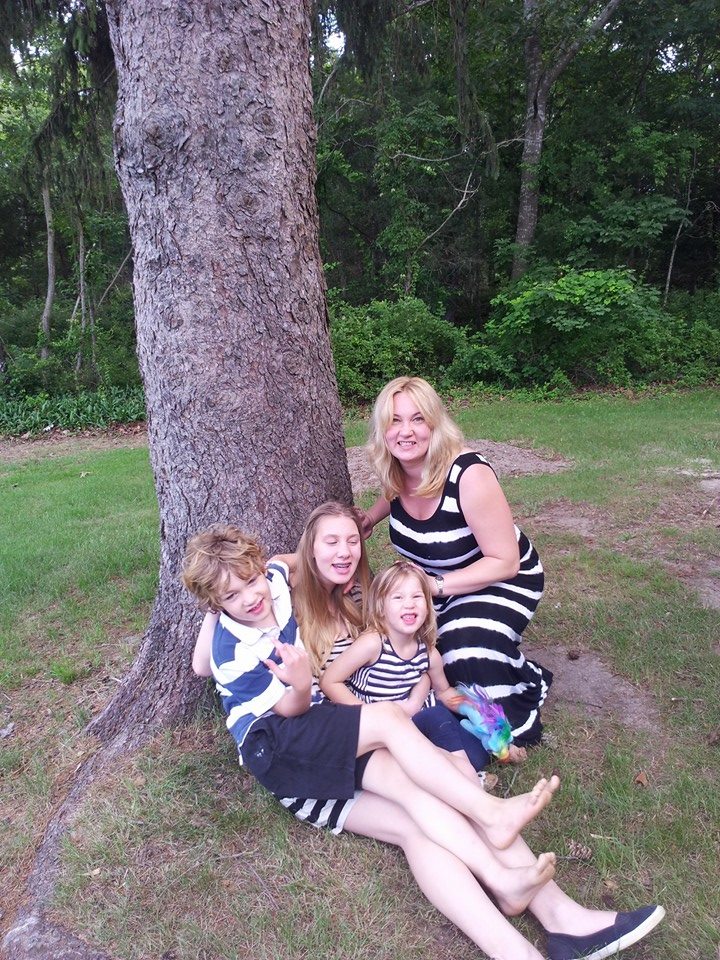
How did the idea of a German weekend school come about?
I’ve got involved in the German community through my husband’s German college. We became good friends, and we were wondering what would happen to our children if we wanted to move back to Germany in a few years. If they don’t know the language well, they won’t be able to reintegrate and keep up with the more rigorous education systems back home. Thus, we started a German school with a few children. More and more children enrolled, then the Deutsche Sprachschule Long Island was founded. Later, parents showed up to learn German as a foreign language, so I started teaching adults. I had many students who had lived in Germany for a couple of years and they didn’t want to let their language skills fade. When the Covid pandemic hit, we switched to online teaching, and have remained that way ever since. Now I have two classes, and I really enjoy teaching because this way I haven’t forgotten the language. I’ve been teaching some of my students for seven years and it’s great to be able to talk about anything in German. Sometimes I organize meetings in person, for example I invite them to a picnic on the beach or take them on a field trip to a museum. In addition, the German school has community events, such as St Martin’s Day in November or Santa Claus in December. We now have about 40 adults and about 60 kids. Originally, the focus was on teaching German culture and history for children, since all our initial students were heritage learners, but it has shifted towards teaching German as a foreign language for adults. I see this trend also in most Hungarian weekend schools. By the way, all of my volunteer work played a big role in my later integration into the Hungarian community.
What about your children? When did you get involved with the Hungarian community?
Juli is now 23 years old. She went to a German weekend school when she was in preschool, she has since graduated from university and is now doing her PhD program in Germany as a biologist at the Max Planck Institute. Peti is 16, Emma is 14. During the Covid era I started teaching them German online along with other kids. We got to an advanced level in a year, but then we stopped. When taking Juli to the German weekend school, I searched for and found the Arany János Hungarian School in the then still existing Hungarian neighborhood of Manhattan (Yorkville, Upper East Side of New York City). I started to take Juli there. She soon told me that her school friend was a Hungarian scout, and she wanted to join, too. She had an excellent class in the Hungarian School class, with very motivated children and teachers. Soon I found myself teaching Hungarian as a foreign language to adults, then became involved in the PTA and was asked to become the school principal.
How big was the school then and what was your experience as the principal?
There were about 80 children. The biggest difficulty we had was that we rented the rooms of the American school in the Saint Stephen’s School building, and they constantly had problems with us. The legal background was not quite in order either. The school was under the auspices of the scouts, as it was founded by two adult scouts back in the 1960s and the close collaboration between the scouts and the school has endured ever since. I realized that we didn’t even have waiver forms signed by the parents, nor a proper website, nor even a yearbook—all of which I introduced. I’m very grateful to my predecessors, because they did their best. My educational background and expertise were instrumental in establishing a more professional environment at the school.
‘Our national holidays…are significant not only for their commemorative value but also for the shared consciousness they create within our community’
I think my greatest achievement was to create a friendly school community. The teachers and parents held me in high regard and showed genuine appreciation for my contributions. I introduced the routine of having at least a monthly teachers’ meeting. I asked them to pay more attention to each other. We implemented a routine for regular teachers’ meetings, encouraging staff to pay more attention to one another. I tried to activate the parents, too. I engaged them also by introducing folk dance classes and a lunch program, where a parent prepared a large meal that we could purchase and enjoy together—fostering a sense of community, allowing parents from different classes to connect over lunch. Our national holidays, such as 23 October and 15 March, are significant not only for their commemorative value but also for the shared consciousness they create within our community.
The loss of the church in 2015 put the school in a difficult situation…
Yes, we were forced to leave. I remember that August, when there was no place to open the school in September… We ultimately moved to the Hungarian House; one class started to operate on the corridor under the racks, the other in the musty scout room, but at least we could start the school year. It was then that we realized that school was not about the building, but about the community. The move was also good in the sense that scouting started right after school, so no one had to go anywhere else. The school operated very well, but by the fifth year I became tired of running it. Not because of the amount of work, but because of the personal conflicts. By then AMIT had also been going on for five years and my own children were getting to the age where they needed more attention from me. Thus, when Juli graduated, I decided to retire as well. Eventually, we arranged for one of the teachers to be the kindergarten principal and another teacher to be the school principal, but the latter quit after a year. Currently Endre Mészáros has been running it for years. They are doing well, receiving a lot of financial support.
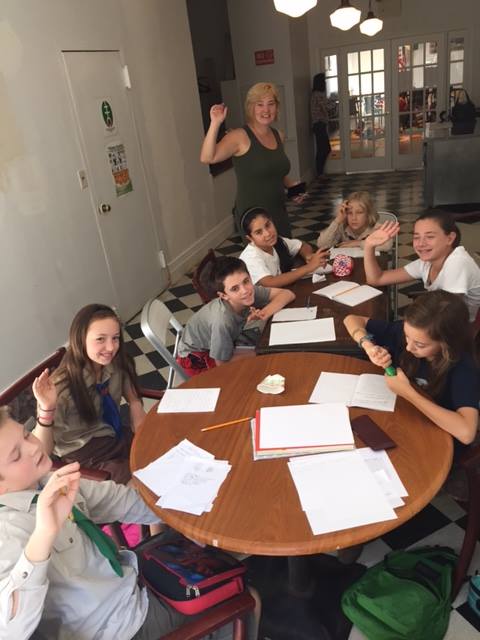
Let’s turn to AMIT, which you co-founded with Dr. Judit Kerekes.
I became familiar with an umbrella organization for German weekend schools. The German Language School Conference (GLSC) hosts an annual meeting each November at the German Consulate in New York. I believed that Hungarians should organize a similar event, as it would allow us all—including myself—to learn from each other, particularly in how to manage weekend schools.
We were lucky in the Manhattan Hungarian School because most of our teachers were graduates from the Carpathian Basin or Hungary, but operating in a heritage school is in a different league. Károly Dán was the Hungarian Consul General at that time. I invited him to the school’s 50th anniversary event and explained to him what a sacrifice it was for teachers, parents and children alike to come to the school for half a day during their weekends. I don’t think anyone who hasn’t experienced it understands the effort involved. However, many people are now aware, including Hungarian consulates across the U.S. as well as the State Secretariat for National Policy—thanks, I think, also to AMIT—of what a weekend Hungarian school is. The Consul General was enthusiastic, he came to give a speech at the anniversary event and thanks to him the first AMIT was held in the building of the Consulate General in 2013.
At the beginning there were a lot of phone calls and emails, but as social media developed, it became easier to communicate, organize and share best practices. In any case, it was a very rewarding experience to call someone on the other side of America and after three minutes we understood each other. It was a good feeling to find out that I’m not the only one who is crazy enough to spend all her spare time, money and energy on volunteering and education. The participants at the first meeting were mainly from the East Coast, but over time more and more people started to join. By now we have 36 Hungarian weekend schools in America and another 16 in Canada. Our online events are very popular, attended by sometimes up to 120 people from all over the world, even from Australia and Europe.
I assume the AMIT team has also grown in the meantime…
Yes. At the beginning there were just three of us: Judit Kerekes and Attila Lukács, a mathematics teacher, helping us. Then Zsuzsa Tamás joined. László Hámos, the then president of the Diaspora Council invited me to a Diaspora Council meeting, where I met Eszter Gagnon. She got involved immediately and brought a lot of technical and professional support, putting together an international team and setting up the Foundational Program for Hungarian Language and Heritage. Recently, we created a Spotify channel where one can learn Hungarian via listening to various styles of (Hungarian) music. Bernadett Czettisch joined the team as our communication director, specializing in social media. Tomi Marshall took on the role of professional development manager, while Ági Vámos became our treasurer. Although Judit Haála moved back to Hungary, she remains part of the AMIT team. Today, AMIT functions as a collaborative effort with a wider range of activities beyond the annual conference, which continues to be a significant undertaking.
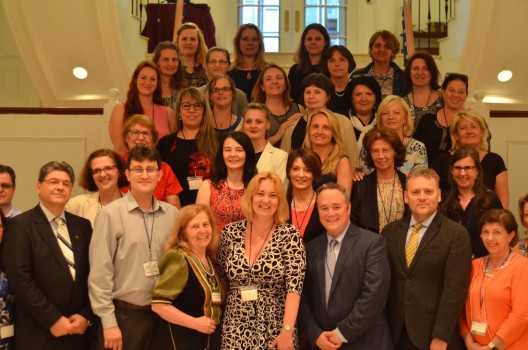
We now have a serious website with very rich bilingual content and an educational platform. I send out a bilingual newsletter regularly. I frequently attend various forums, such as the annual conferences of the American Hungarian Educators Association (AHEA), where I promote AMIT, because many people still don’t know about it or don’t understand the basic concept. We became a registered organization in 2017. We cooperate with the Tulipán Foundation, the Pedagogical Society, the Hungarian House and the Consulate General of Hungary. We have a teachers’ and a principals’ online chat group to keep in touch and think together. We take our slogan seriously—’We put the pieces together’—; we strive to anticipate needs by selecting event topics that will resonate broadly with our audience. The role of AMIT has become particularly important under Covid. Obviously, online education came to the fore, and we also got a very good Kőrösi Csoma Sándor Program scholar, who started to organize webinars called AMIT Tali. We meet not only to discuss technical or pedagogical professional topics, but we have had writer–reader meetings too. We have also organized teacher training courses and ECL language exams. Twice during Covid times, when the annual scout camp and the Hungarian school camp were cancelled, we organized a reading camp with 65 children—involving six time zones and six reading levels—with 10–12 teachers. The following year we organized online meetings with the authors, Judit Berg and Gábor Nógrádi. After Covid, children were eager to meet in person, and there weren’t enough volunteer teachers to carry on the reading camps.
Nevertheless, you still have other exciting events, like at this year’s AMIT titled Music for All!
Yes, I think we had a fantastic AMIT conference this year themed around music, with among others Rita Uzsalyné Pécsi being our keynote speaker from Hungary; but most importantly, we managed to create a real community. After the conference we talked to the school principals and teachers until 3 am and laughed a lot. This is a real community of people who help each other, not just professionally, but also in our private lives. If I were to call any of them right now, asking if I could stay at their place or if they could help me with something, they would say yes without hesitation. There is an AMIT song I wrote and composed providing an account of this feeling, of what AMIT means to us.
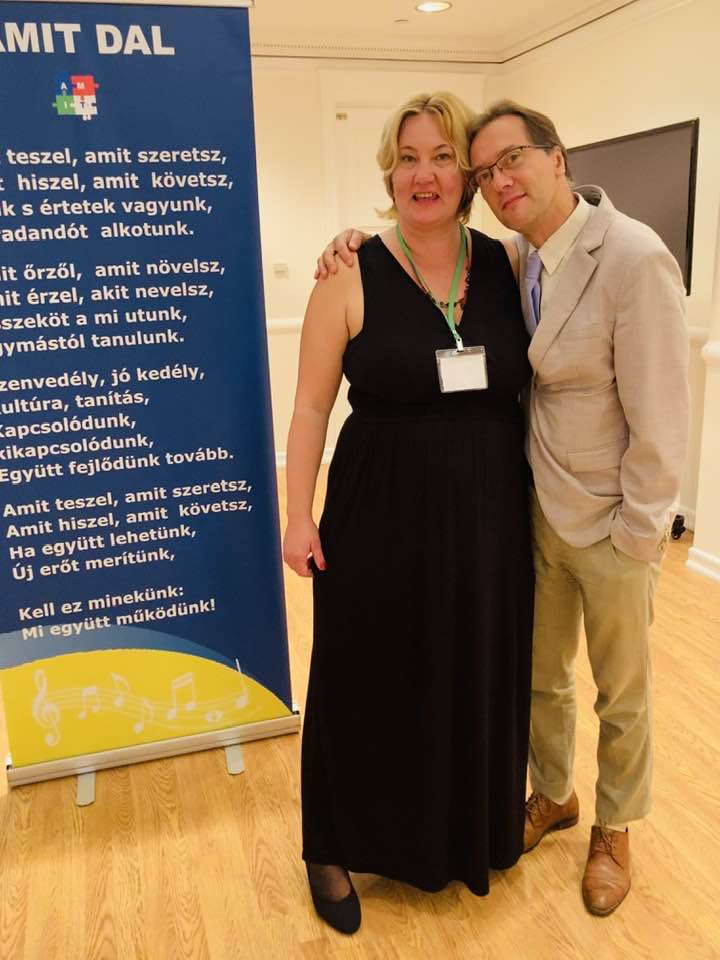
Having a broad insight into the world of Hungarian weekend schools in the North American diaspora, what do you think their main challenges are?
I have a close insight into the Hungarian weekend schools in New York and New Brunswick, New Jersey as well as in Minnesota because I taught there online for a year at Betti Czettisch’s request. I was teaching at the Hungarian School Camp in Fillmore, New Jersey and co-taught a class with Lívia Schachinger at the last Kodály scout weekend, where my daughter Juli was the scout camp director. And I know a lot about the others. It’s difficult to generalize as these schools are very different. Some work closely with scouting, others have no scouting at all in their vicinity. Some meet for two hours every two weeks, others for four hours every week. Some have students who can all speak Hungarian, while in others only half of them do.
However, what every weekend Hungarian school struggles with are three or four basic challenges. I think the next AMIT conference will be about this topic. The first thing that comes to mind is communication with parents. How do we involve them in the life of the school and in their children’s learning process? Many parents still think that taking their children to school for one or two hours a week is enough to learn the language, and they don’t understand why their child hasn’t learned it well. The other issue is the digital addiction which affects the children’s nervous system, and that is why there are so many students nowadays with attention deficit disorder, autism, Asperger syndrome, and all kinds of special educational needs and learning difficulties. We have a lot of interviews and articles on this subject available on our website, by for example well-known experts such as Éva Gyarmati, Emőke Bagdy or Annamária Tari, and as mentioned we recently had Rita Uzsayné Pécsi with us in person, too. We often invite experts, psychologists who can help us understand how to involve the children with special needs in the community and how to evaluate the community’s level of acceptance regarding these children.
What’s also challenging is retaining the 14–16-year-olds. Many teenagers drop out of the weekend schools due to other responsibilities. This group often faces competing sports commitments instead, which I can fully understand. The fourth general challenge is that they have more and more mixed language families, where children speak less and less Hungarian, while most schools do not have enough teachers to start Hungarian as a foreign language class. Involving non-Hungarian (speaking) parents from mixed language backgrounds is also a big challenge—I would like to continue addressing this issue within AMIT. As a first step, I started writing bilingual newsletters. At the AHEA conference last year I realized that I had lost two thirds of my audience by giving a lecture on AMIT in Hungarian. So, this year I gave my presentation in English. Reading camp was a great way to involve Hungarian as a second language learners, as is folk dancing. Finally, what I also see as another major challenge—not only for schools, but for most diaspora organizations—is the lack of cooperation within and between organizations. Everyone is promoting their own agenda and people easily attack or criticize each other, forgetting that the main point is that we are all part of a global community, so we should be respectful to each other and set a good example to others—because children will imitate what they see around them.
These are already five challenges, and you haven’t mentioned what many others complain about: the teacher shortage. Is that not a general problem?
It’s indeed difficult to find qualified teachers, let alone volunteers, or people who will give up their Saturdays for a symbolic compensation. From another perspective, what are the chances of a Hungarian teacher with a degree moving to, for example, Minnesota anyway? Not much. Having said that, I’m not sure that qualifications are the most important in this respect. One of our best preschool teacher didn’t even have an educational background, however, because of her strong intuition and deep connection with the children, they loved her regardless. In any case, at a Hungarian weekend school, teachers have to be able to teach all sorts of subjects—literature, grammar, history, geography, music, etc.—having a unique approach. Content is also a real challenge—the AMIT educational platform can help a lot with that. And at last but not least, let’s not forget that what truly matters is leading by example in how we treat and communicate with one another.
Read more Diaspora interviews:

